Mapping Two Decades of AI in Construction Research: A Scientometric Analysis from the Sustainability and Construction Phases Lenses
Abstract
:1. Introduction and Background
- Economic sustainability: The ability of construction projects to create long-term economic value while considering the needs of both present and future generations. It involves ensuring the financial viability of construction projects, promoting fair trade practices, supporting local economies, and optimizing resource allocation [5]. This pillar emphasizes the importance of cost-effectiveness, profitability, and the long-term economic benefits derived from sustainable construction practices [29,30].
- Social sustainability: Meeting the needs and improving the quality of life for individuals and communities affected by construction projects. It encompasses factors such as social equity, inclusivity, health, safety, and well-being. Socially sustainable construction practices involve providing safe working conditions, promoting diversity and equal opportunities, respecting local cultures and traditions, and enhancing community engagement throughout the project lifecycle [28].
- Environmental sustainability: Minimizing the negative impact of construction activities on the natural environment. It involves practices that conserve resources, reduce pollution, promote energy efficiency, and mitigate climate change [31]. Examples include using renewable energy sources, employing sustainable construction materials, reducing waste generation, and implementing effective water and land management strategies [32].
- Governance sustainability: Promoting transparency, accountability, and ethical decision-making in construction projects. It emphasizes the importance of effective governance structures, policies, and regulations to ensure compliance with environmental, social, and economic standards. This pillar focuses on promoting responsible practices, preventing corruption, establishing clear frameworks for decision-making, and fostering collaboration between stakeholders to achieve sustainable outcomes [33].
2. Methodology
3. Results
3.1. General Observations
3.2. Academic Influence Analysis
3.2.1. Citation Analysis by Publication
3.2.2. Citation Analysis by University
3.2.3. Citation Analysis by Country
3.3. Research Clusters of AI in the Construction Literature
- Cluster 1 (Automation): Using technology to automate repetitive tasks and improve efficiency and safety.
- Cluster 2 (Big data): Analyzing large volumes of data to improve decision-making.
- Cluster 3 (Digital twin): Creation of a virtual replica of a physical asset such as a building or infrastructure project, allowing for optimized designs and improved collaboration between stakeholders.
- Cluster 4 (Deep learning): Uses artificial neural networks to analyze data and make predictions in construction, including quality control for materials such as concrete and steel.
- Cluster 5 (Machine learning): Using data and algorithms to make predictions and identify hazards.
- Cluster 6 (Information systems): Software and hardware used to manage and process project data.
- Cluster 7 (Simulation): Using software to model materials, structures, and construction processes to identify potential issues before construction begins.
3.4. Historical Research Clusters of AI in the Construction Research
- The earliest research clusters in AI in construction were Automation (Cluster 1) and Information systems (Cluster 6), which laid the groundwork for the field.
- Simulation (Cluster 7) was the first extended research orientation of AI in construction, but it had a relatively weak link to other clusters.
- The earliest research clusters that started to reduce the aggregation of Clusters 6 and 7 were Machine learning (Cluster 5) and big data (Cluster 3).
- Automation (Cluster 1) has been the most popular extended research orientation of AI in construction over the past two decades (2000 to 2023).
- Deep learning (Cluster 4) has recently emerged as a significant cluster in AI in construction, driven by advances in technology from Digital twin (Cluster 2) and big data (Cluster 3). It has strong links with other relevant research clusters. In the past 6 years, Deep learning (Cluster 4) has replaced Automation (Cluster 1) and Information systems (Cluster 6) as the most popular cluster in AI in construction (excluding AI).
3.5. Research Clusters in the Context of AI and Sustainability
3.6. Historical Research Clusters of Sustainability in the Construction Domain
3.7. Research Clusters in the Context of AI in Construction Phases
3.8. Historical Research Clusters of the Construction Phases
4. Findings and Discussion
- Design Complexity and Optimization: Modern construction projects involve complex designs that must be optimized for various factors, including structural stability, energy efficiency, and cost-effectiveness. AI-powered algorithms can analyze countless design variations to identify optimal solutions quickly, enhancing design efficiency and accuracy [41].
- Project Planning and Scheduling: The complexity of construction project schedules often leads to delays, resource conflicts, and cost overruns. AI can analyze historical project data, real-time progress, and external factors to generate dynamic and adaptable schedules that account for uncertainties and potential disruptions [45].
- Risk Assessment and Management: The construction industry has constant uncertainties that can lead to project risks. AI’s predictive analytics can forecast potential risks by analyzing historical data and project parameters, enabling proactive risk mitigation strategies and better-informed decision-making [33].
- Quality Control and Defect Detection: Ensuring the quality of construction work is a persistent challenge. AI-powered visual recognition systems can detect defects, discrepancies, and deviations from design plans by comparing real-time construction progress to digital models, ensuring adherence to specifications and standards [48].
- Resource Allocation and Management: Efficiently allocating labor, materials, and equipment is vital for project success. AI can optimize resource allocation by analyzing project requirements, availability, and constraints, thus minimizing waste, and enhancing resource utilization [2].
- Safety Monitoring and Compliance: Safety concerns are paramount in construction. AI-driven sensors, cameras, and wearable devices can monitor work environments for potential safety hazards in real time, alerting workers, and supervisors to risks and ensuring compliance with safety regulations [35].
- Data Integration and Collaboration: Construction projects involve multiple stakeholders, each contributing diverse data sources. AI can facilitate seamless data integration, enabling improved collaboration among project teams and decision-makers by providing a unified platform for information sharing and analysis [47].
- Supply Chain Optimization: Managing the supply chain efficiently to ensure timely delivery of materials and resources is a significant challenge. AI algorithms can predict demand, optimize procurement, and monitor logistics to prevent disruptions and delays [52].
- Environmental Impact Mitigation: Sustainable construction practices are essential for minimizing the industry’s environmental footprint. AI can assess and model the environmental impact of construction activities, suggesting eco-friendly materials, energy-efficient designs, and waste reduction strategies [10].
- Post-Construction Maintenance and Operations: Maintaining and operating constructed assets efficiently is an ongoing challenge. AI-powered predictive maintenance algorithms can analyze real-time data from sensors to anticipate maintenance needs and optimize asset performance [26].
5. Conclusions
Author Contributions
Funding
Data Availability Statement
Conflicts of Interest
References
- Abdirad, H.; Mathur, P. Artificial intelligence for BIM content management and delivery: Case study of association rule mining for construction detailing. Adv. Eng. Inform. 2021, 50, 101414. [Google Scholar] [CrossRef]
- Abioye, S.; Oyedele, L.; Akanbi, L.; Ajayi, A.; Davila Delgado, J.; Bilal, M.; Ahmed, A. Artificial intelligence in the construction industry: A review of present status, opportunities and future challenges. J. Build. Eng. 2021, 44, 103299. [Google Scholar] [CrossRef]
- Akhavian, R.; Behzadan, A.H. Smartphone-based construction workers’ activity recognition and classification. Autom. Constr. 2016, 71, 198–209. [Google Scholar] [CrossRef]
- Akinosho, T.; Oyedele, L.; Bilal, M.; Ajayi, A.; Delgado, M.; Akinade, O.; Ahmed, A. Deep learning in the construction industry: A review of present status and future innovations. J. Build. Eng. 2020, 32, 101827. [Google Scholar] [CrossRef]
- Amusan, L.; Aigbavboa, C.; Fayomi, O.; Owolabi, J. Lean thinking and industrial 4.0 approach to achieving construction 4.0 for industrialization and technological development. Buildings 2020, 20, 221. [Google Scholar]
- Antwi-Afari, P.; Ng, S.; Hossain, M. A review of the circularity gap in the construction industry through scientometric analysis. J. Clean. Prod. 2021, 298, 126870. [Google Scholar] [CrossRef]
- Arbolino, R.; Carlucci, F.; De Simone, L.; Ioppolo, G.; Yigitcanlar, T. The policy diffusion of environmental performance in the European countries. Ecol. Indic. 2018, 89, 130–138. [Google Scholar] [CrossRef]
- Armstrong, G.; Gilge, C.; Max, K.; Vora, S. Familiar Challenges, New Approaches: 2023 Global Construction Survey. Available online: https://assets.kpmg.com/content/dam/kpmg/xx/pdf/2023/06/familiar-challenges-new-solutions.pdf (accessed on 2 August 2023).
- Ashokkumar, V.; Varghese, S. BIM based 3D model for construction waste quantification. Int. Res. J. Eng. Technol. 2018, 5, 3069–3076. [Google Scholar]
- Asteris, P.; Skentou, A.; Bardhan, A.; Samui, P.; Pilakoutas, K. Predicting concrete compressive strength using hybrid ensembling of surrogate machine learning models. Cem. Concr. Res. 2021, 145, 106449. [Google Scholar] [CrossRef]
- Bigham, G.; Adamtey, S.; Onsarigo, L.; Jha, N. Artificial intelligence for construction safety: Mitigation of the risk of fall. In Proceedings of SAI Intelligent Systems Conference; Springer: Cham, Switzerland, 2018; pp. 1024–1037. [Google Scholar]
- Bilal, M.; Oyedele, L.; Qadir, J.; Munir, K.; Ajayi, S.; Akinade, O.; Owolabi, H.; Alaka, H.; Pasha, M. Big data in the construction industry: A review of present status, opportunities, and future trends. J. Clean. Prod. 2021, 298, 126889. [Google Scholar] [CrossRef]
- Blanco, J.; Fuchs, S.; Parsons, M.; Ribeirinho, M. Artificial intelligence: Construction technology’s next frontier. Build. Econ. 2018, 9, 7–13. [Google Scholar]
- Brilakis, I.; Park, M.; Jog, G. Automated vision tracking of project related entities. Adv. Eng. Inform. 2011, 25, 713–724. [Google Scholar] [CrossRef]
- Chui, M.; Francisco, S. Artificial Intelligence the Next Digital Frontier? McKinsey and Company Global Institute: New York, NY, USA, 2017. [Google Scholar]
- Darko, A.; Chan, A.; Adabre, M.; Edwards, D.; Hosseini, M.; Ameyaw, E. Artificial intelligence in the AEC industry: Scientometric analysis and visualization of research activities. Autom. Constr. 2020, 112, 103081. [Google Scholar] [CrossRef]
- Delgado, J.; Oyedele, L. Digital twins for the built environment: Learning from conceptual and process models in manufacturing. Adv. Eng. Inform. 2021, 49, 101332. [Google Scholar] [CrossRef]
- Eber, W. Potentials of artificial intelligence in construction management. Organ. Technol. Manag. Constr. 2020, 12, 2053–2063. [Google Scholar] [CrossRef]
- Faisal, A.; Yigitcanlar, T.; Kamruzzaman, M.; Paz, A. Mapping two decades of autonomous vehicle research: A systematic scientometric analysis. J. Urban Technol. 2021, 28, 45–74. [Google Scholar] [CrossRef]
- Gamil, Y.; Abdullah, M.; Abd Rahman, I.; Asad, M. Internet of things in construction industry revolution 4.0: Recent trends and challenges in the Malaysian context. J. Eng. Des. Technol. 2020, 18, 1091–1102. [Google Scholar] [CrossRef]
- Ginzburg, A.; Kuzina, O.; Ryzhkova, A. Unified resources marking system as a way to develop artificial intelligence in construction. Mater. Sci. Eng. 2018, 365, 062021. [Google Scholar] [CrossRef]
- Golparvar-Fard, M.; Peña-Mora, F.; Savarese, S. Automated progress monitoring using unordered daily construction photographs and IFC-based building information models. J. Constr. Eng. Manag. 2011, 137, 625–635. [Google Scholar] [CrossRef]
- Grover, P.; Kar, A.; Dwivedi, Y. Understanding artificial intelligence adoption in operations management: Insights from the review of academic literature and social media discussions. Ann. Oper. Res. 2022, 308, 177–213. [Google Scholar] [CrossRef]
- Han, K.; Golparvar-Fard, M. Potential of big visual data and building information modeling for construction performance analytics: An exploratory study. Autom. Constr. 2017, 73, 184–198. [Google Scholar] [CrossRef]
- Kim, M.; Chi, H.; Wang, X.; Ding, L. Automation and robotics in construction and civil engineering. J. Intell. Robot. Syst. 2015, 79, 347. [Google Scholar] [CrossRef]
- Li, C.Z.; Xue, F.; Li, X.; Hong, J.; Shen, G.Q. An Internet of Things-enabled BIM platform for on-site assembly services in prefabricated construction. Autom. Constr. 2018, 89, 146–161. [Google Scholar] [CrossRef]
- Li, W.; Yigitcanlar, T.; Liu, A.; Erol, I. Mapping two decades of smart home research: A systematic scientometric analysis. Technol. Forecast. Soc. Chang. 2022, 179, 121676. [Google Scholar] [CrossRef]
- Lin, J.; Golparvar-Fard, M. Visual Data and Predictive Analytics for Proactive Project Controls on Construction Sites; Springer: Berlin/Heidelberg, Germany, 2018; pp. 412–430. [Google Scholar]
- Liu, P.; Chen, A.Y.; Huang, Y.N.; Han, J.Y.; Lai, J.S.; Kang, S.C.; Wu, T.H.; Wen, M.C.; Tsai, M.H. A review of rotorcraft unmanned aerial vehicle (UAV) developments and applications in civil engineering. Smart Struct. Syst. 2014, 13, 1065–1094. [Google Scholar] [CrossRef]
- Liu, H.; Wang, G.; Huang, T.; He, P.; Skitmore, M.; Luo, X. Manifesting construction activity scenes via image captioning. Autom. Constr. 2020, 119, 103334. [Google Scholar] [CrossRef]
- Liu, Z.; Osmani, M.; Demian, P.; Baldwin, A. A BIM-aided construction waste minimisation framework. Autom. Constr. 2015, 59, 1–23. [Google Scholar] [CrossRef]
- Louis, J.; Dunston, P. Integrating IoT into operational workflows for real-time and automated decision-making in repetitive construction operations. Autom. Constr. 2018, 94, 317–327. [Google Scholar] [CrossRef]
- Lu, Q.; Parlikad, A.; Woodall, P.; Don Ranasinghe, G.; Xie, X.; Liang, Z. Developing a digital twin at building and city levels: Case study of West Cambridge campus. J. Manag. Eng. 2020, 36, 05020004. [Google Scholar] [CrossRef]
- Mahbub, R. An Investigation into the Barriers to the Implementation of Automation and Robotics Technologies in the Construction Industry. 2008. Available online: https://eprints.qut.edu.au/26377/1/Rohana_Mahbub_Thesis.pdf (accessed on 23 July 2023).
- Naser, M. AI-based cognitive framework for evaluating response of concrete structures in extreme conditions. Eng. Appl. Artif. Intell. 2019, 81, 437–449. [Google Scholar] [CrossRef]
- Neelamkavil, J. Automation in the prefab and modular construction industry. In Proceedings of the 26th Symposium on Construction Robotics ISARC, Austin, TX, USA, 21–27 June 2009. [Google Scholar]
- Newman, C.; Edwards, D.; Martek, I.; Lai, J.; Thwala, W.; Rillie, I. Industry 4.0 deployment in the construction industry: A bibliometric literature review and UK-based case study. Smart Sustain. Built Environ. 2021, 10, 557–580. [Google Scholar] [CrossRef]
- Novak, A.; Bennett, D.; Kliestik, T. Product decision-making information systems, real-time sensor networks, and artificial intelligence-driven big data analytics in sustainable Industry 4.0. Econ. Manag. Financ. Mark. 2021, 16, 62–72. [Google Scholar]
- Pan, Y.; Zhang, L. Roles of artificial intelligence in construction engineering and management: A critical review and future trends. Autom. Constr. 2019, 99, 324–340. [Google Scholar] [CrossRef]
- Patil, G. Applications of artificial intelligence in construction management. Int. J. Res. Eng. IT Soc. Sci. 2019, 3, 21–28. [Google Scholar]
- Perveen, S.; Kamruzzaman, M.; Yigitcanlar, T. Developing policy scenarios for sustainable urban growth management: A Delphi approach. Sustainability 2017, 9, 1787. [Google Scholar] [CrossRef]
- Pillai, V.; Matus, K. Towards a responsible integration of artificial intelligence technology in the construction sector. Sci. Public Policy 2020, 47, 689–704. [Google Scholar] [CrossRef]
- Rao, T.; Gaddam, A.; Kurni, M.; Saritha, K. Reliance on artificial intelligence, machine learning and deep learning in the Era of industry 4.0. In Smart Healthcare System Design: Security and Privacy Aspects; Wiley: Hoboken, NJ, USA, 2021. [Google Scholar]
- Regona, M.; Yigitcanlar, T.; Xia, B.; Li, R. Opportunities and adoption challenges of AI in the construction industry: A PRISMA review. J. Open Innov. Technol. Mark. Complex. 2022, 8, 45. [Google Scholar] [CrossRef]
- Regona, M.; Yigitcanlar, T.; Xia, B.; Li, R. Artificial intelligent technologies for the construction industry: How are they perceived and utilized in Australia? J. Open Innov. Technol. Mark. Complex. 2022, 8, 16. [Google Scholar] [CrossRef]
- Boje, C.; Guerriero, A.; Kubicki, S.; Rezgui, Y. Towards a semantic Construction Digital Twin: Directions for future research. Autom. Constr. 2020, 114, 103179. [Google Scholar] [CrossRef]
- Ribeirinho, M.; Mischke, J.; Strube, G.; Sjodin, E.; Blanco, J.; Palter, R.; Biorck, J.; Rockhill, D.; Andersson, T. The Next Normal in Construction. 2020. Available online: https://www.mckinsey.com/~/media/McKinsey/Industries/Capital%20Projects%20and%20Infrastructure/Our%20Insights/The%20next%20normal%20in%20construction/The-next-normal-in-construction.pdf (accessed on 15 July 2023).
- Schwabe, K.; Teizer, J.; Konig, M. Applying rule-based model-checking to construction site layout planning tasks. Autom. Constr. 2019, 97, 205. [Google Scholar] [CrossRef]
- Shafiq, M.; Matthews, J.; Lockley, S. A study of BIM collaboration requirements and available features in existing model collaboration systems. J. Inf. Technol. Constr. 2013, 18, 148–161. [Google Scholar]
- Sheikhnejad, Y.; Yigitcanlar, T. Scientific landscape of sustainable urban and rural areas research: A systematic scientometric analysis. Sustainability 2020, 12, 1293. [Google Scholar] [CrossRef]
- Shukla, A.; Janmaijaya, M.; Abraham, A.; Muhuri, P. Engineering applications of artificial intelligence: A bibliometric analysis of 30 years (1988–2018). Eng. Appl. Artif. Intell. 2019, 85, 517–532. [Google Scholar] [CrossRef]
- Son, T.; Weedon, Z.; Yigitcanlar, T.; Sanchez, T.; Corchado, J.; Mehmood, R. Algorithmic urban planning for smart and sustainable development: Systematic review of the literature. Sustain. Cities Soc. 2023, 94, 104562. [Google Scholar] [CrossRef]
- Tixier, A.; Hallowell, M.; Rajagopalan, B.; Bowman, D. Application of machine learning to construction injury prediction. Autom. Constr. 2016, 69, 102–114. [Google Scholar] [CrossRef]
- Van Eck, N.; Waltman, L. Citation-based clustering of publications using CitNetExplorer and VOSviewer. Scientometrics 2017, 111, 1053–1070. [Google Scholar] [CrossRef] [PubMed]
- Wang, H.; Pan, Y.; Luo, X. Integration of BIM and GIS in sustainable built environment: A review and bibliometric analysis. Autom. Constr. 2019, 103, 41–52. [Google Scholar] [CrossRef]
- Winfield, A.; Jirotka, M. Ethical governance is essential to building trust in robotics and artificial intelligence systems. Philos. Trans. R. Soc. A 2018, 376, 2133. [Google Scholar] [CrossRef]
- Yao, X.; Zhou, J.; Zhang, J.; Boer, C. From intelligent manufacturing to smart manufacturing for industry 4.0 driven by next generation artificial intelligence and further on. In Proceedings of the 5th International Conference on Enterprise Systems, Beijing, China, 22–24 September 2017. [Google Scholar]
- Yaseen, Z.; Ali, Z.; Salih, S.; Al-Ansari, N. Prediction of risk delay in construction projects using a hybrid artificial intelligence model. Sustainability 2020, 12, 1514. [Google Scholar] [CrossRef]
- Yigitcanlar, T.; Cugurullo, F. The sustainability of artificial intelligence: An urbanistic viewpoint from the lens of smart and sustainable cities. Sustainability 2020, 12, 8548. [Google Scholar] [CrossRef]
- Yigitcanlar, T.; Mehmood, R.; Corchado, J. Green artificial intelligence: Towards an efficient, sustainable and equitable technology for smart cities and futures. Sustainability 2021, 13, 8952. [Google Scholar] [CrossRef]
- Yigitcanlar, T.; Li, R.; Beeramoole, P.; Paz, A. Artificial intelligence in local government services: Public perceptions from Australia and Hong Kong. Gov. Inf. Q. 2023, 40, 101833. [Google Scholar] [CrossRef]
- Zhong, R.; Peng, Y.; Xue, F.; Fang, J.; Zou, W.; Luo, H.; Thomas, S.; Lu, W.; Shen, G.; Huang, G. Prefabricated construction enabled by the internet-of-things. Autom. Constr. 2017, 76, 59–70. [Google Scholar] [CrossRef]
- Golbabaei, F.; Yigitcanlar, T.; Bunker, J. The role of shared autonomous vehicle systems in delivering smart urban mobility: A systematic review of the literature. Int. J. Sustain. Transp. 2021, 15, 731–748. [Google Scholar] [CrossRef]
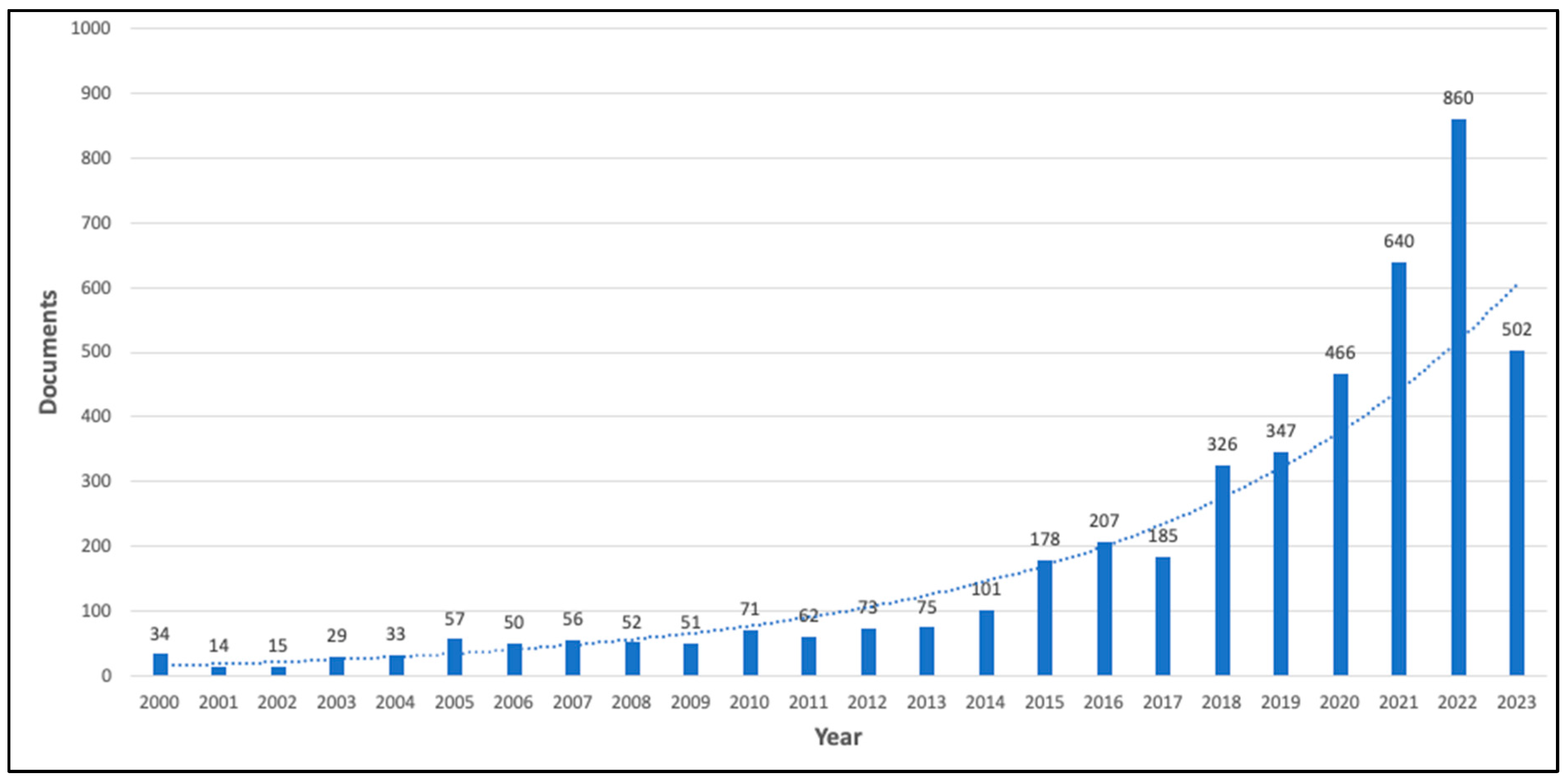




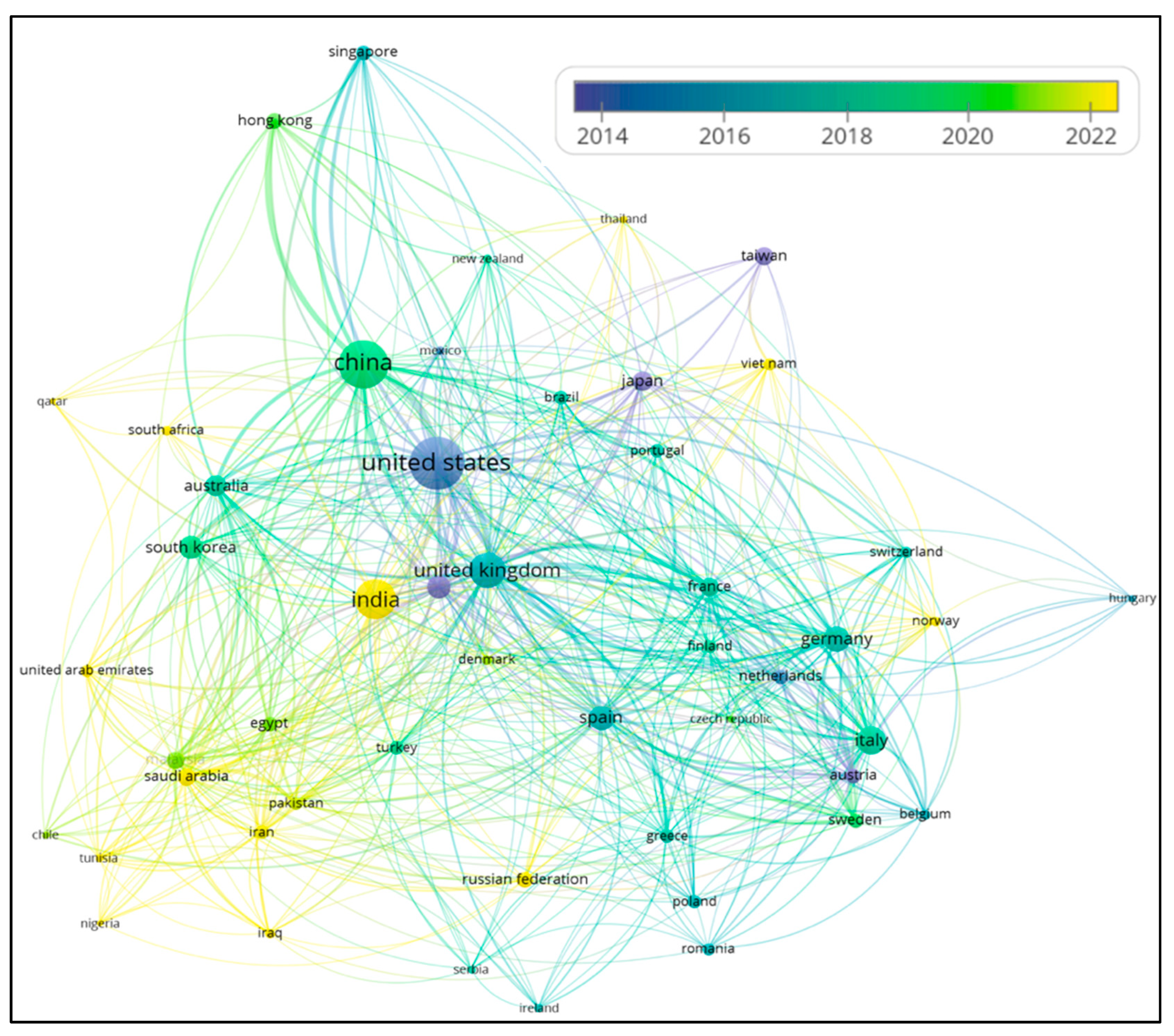
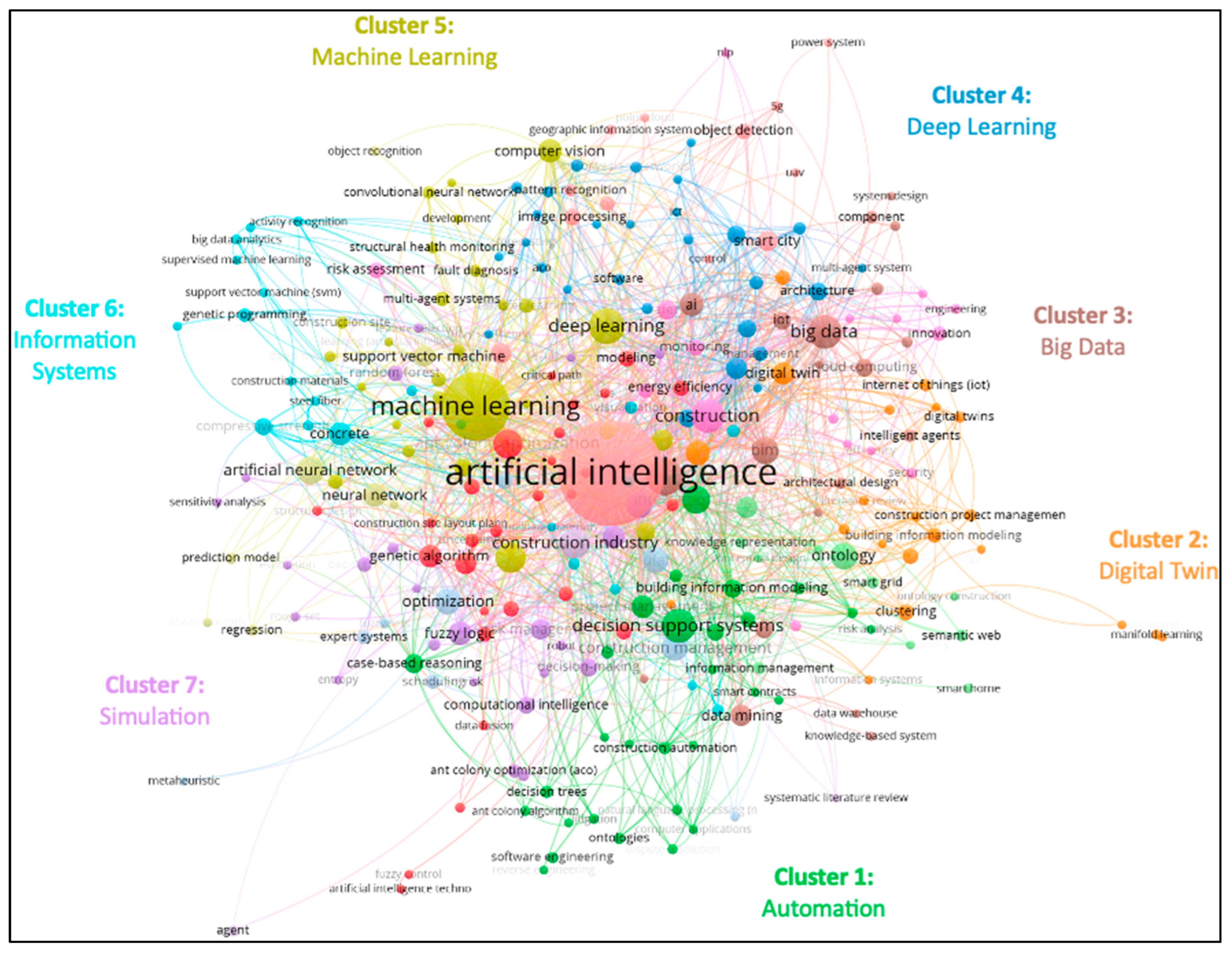
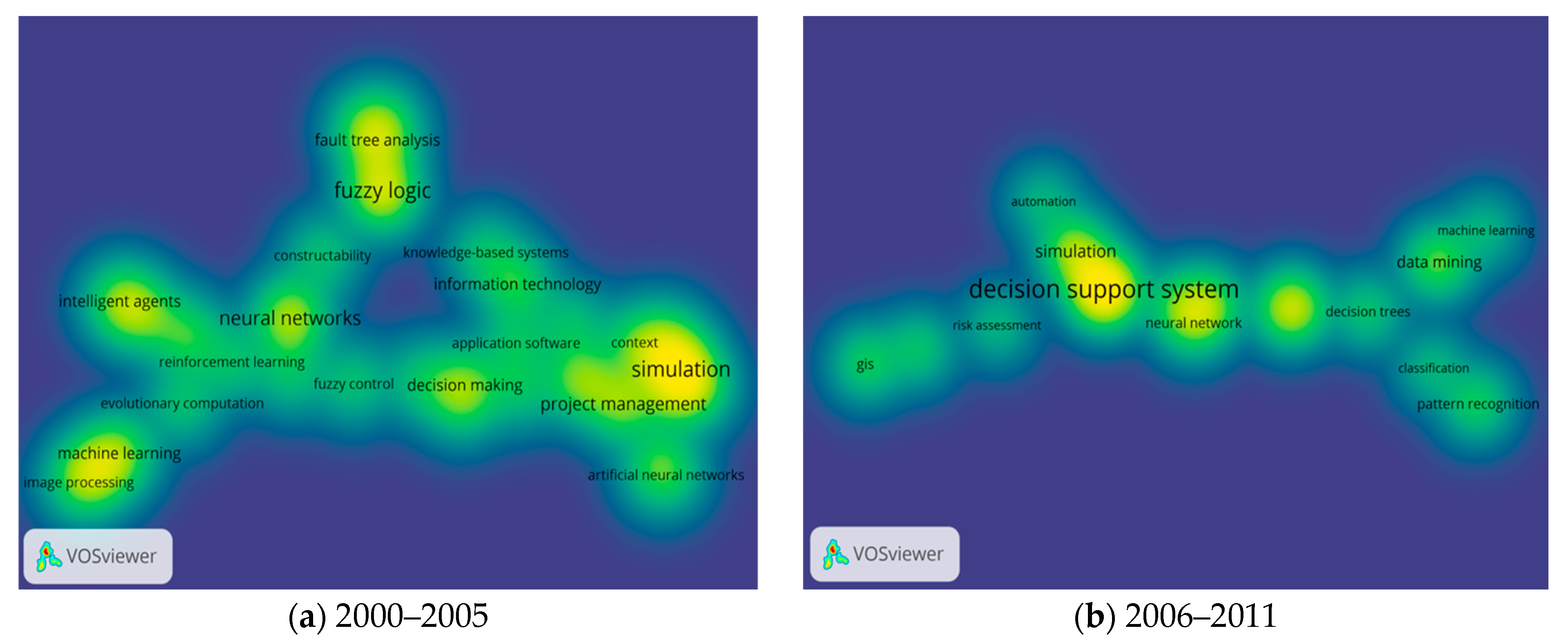
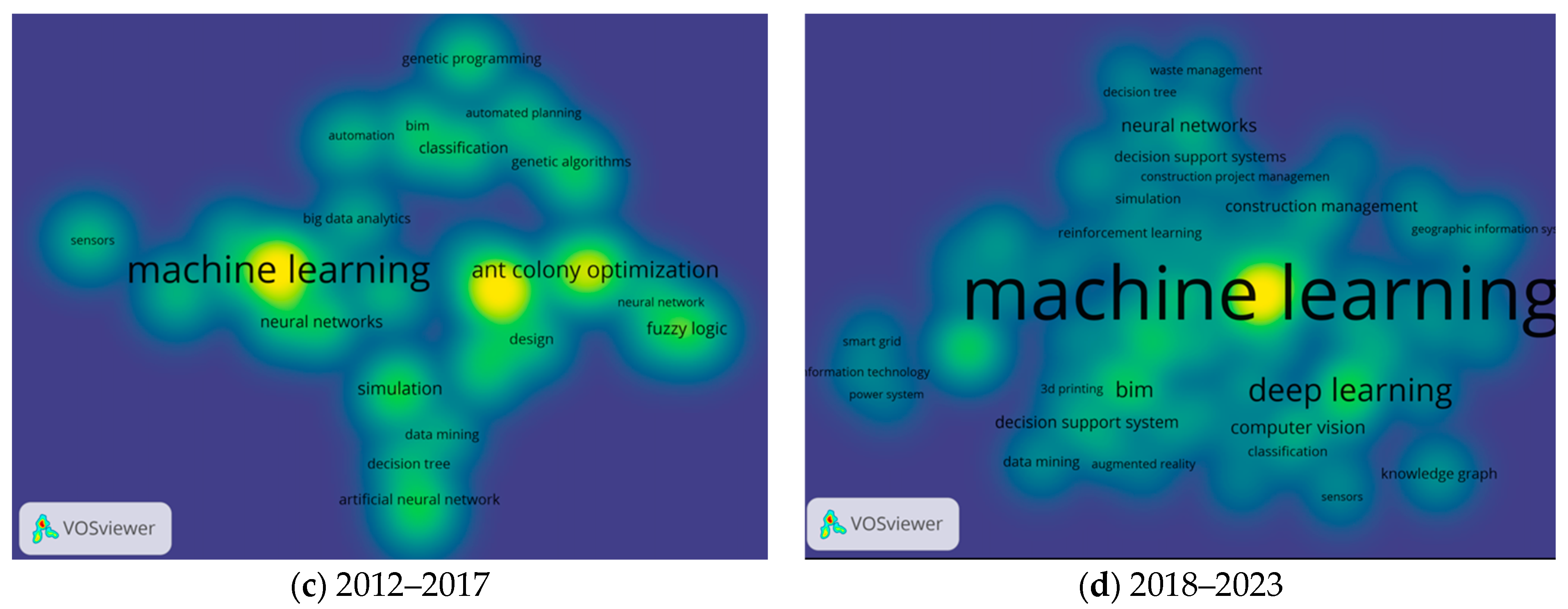
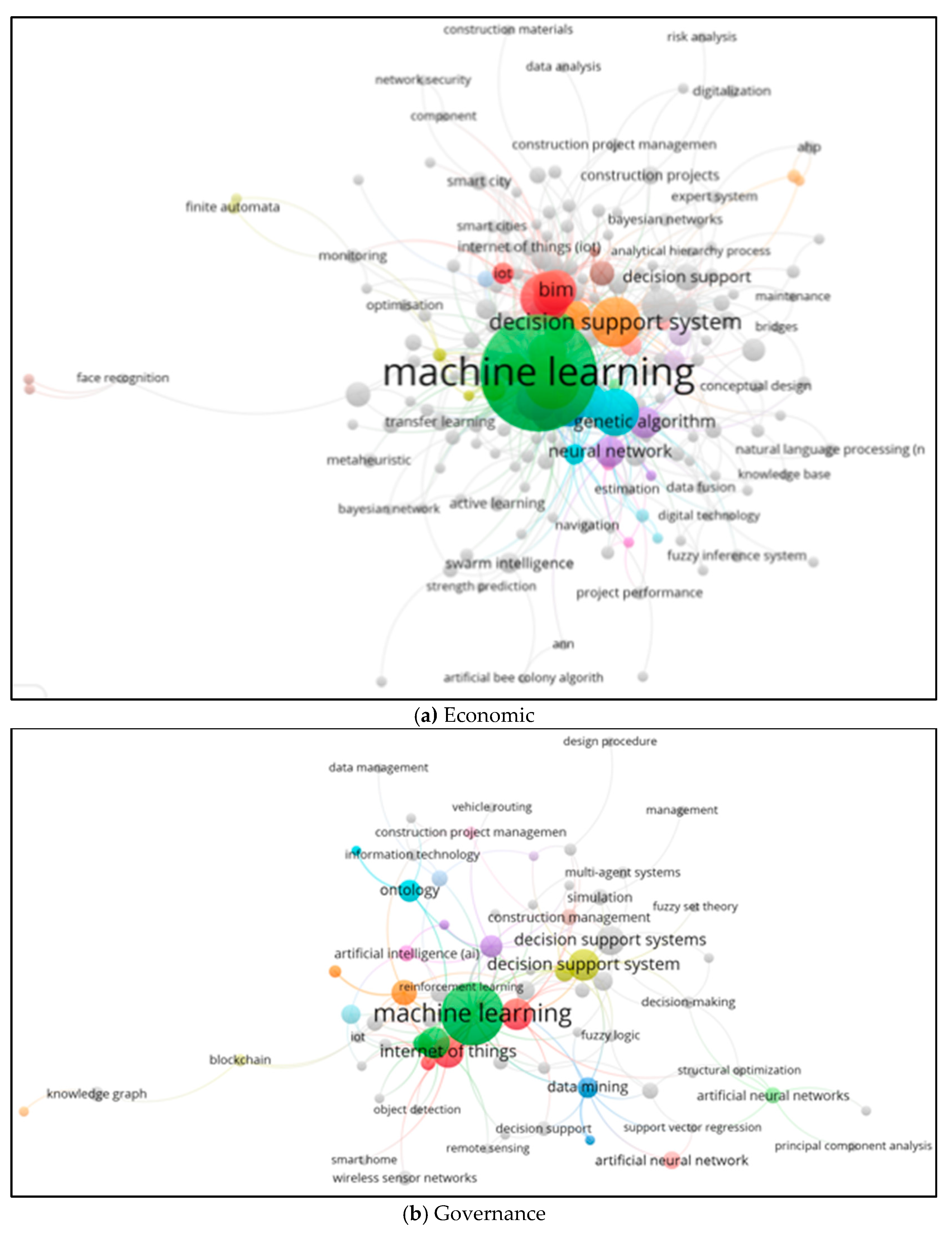
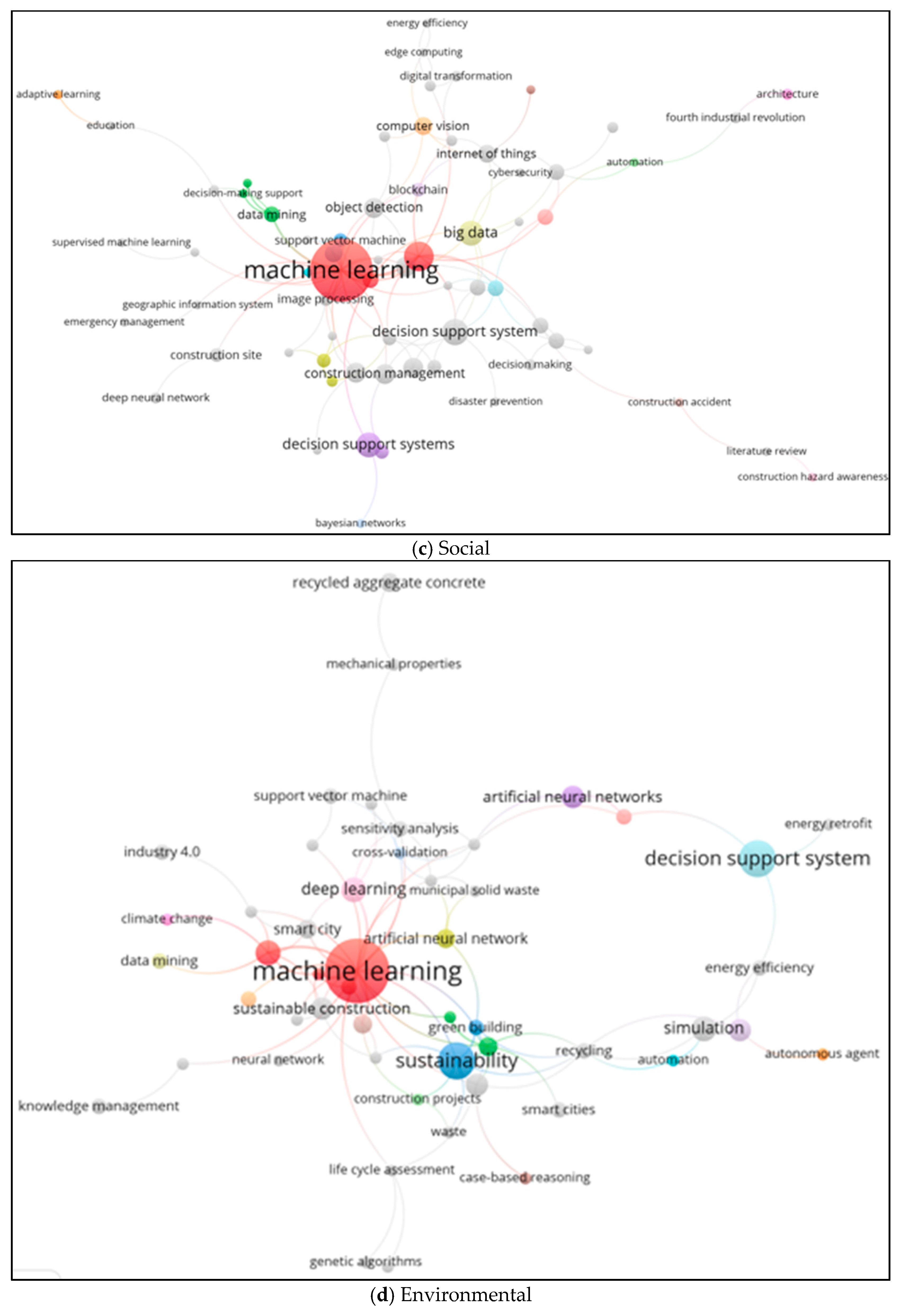
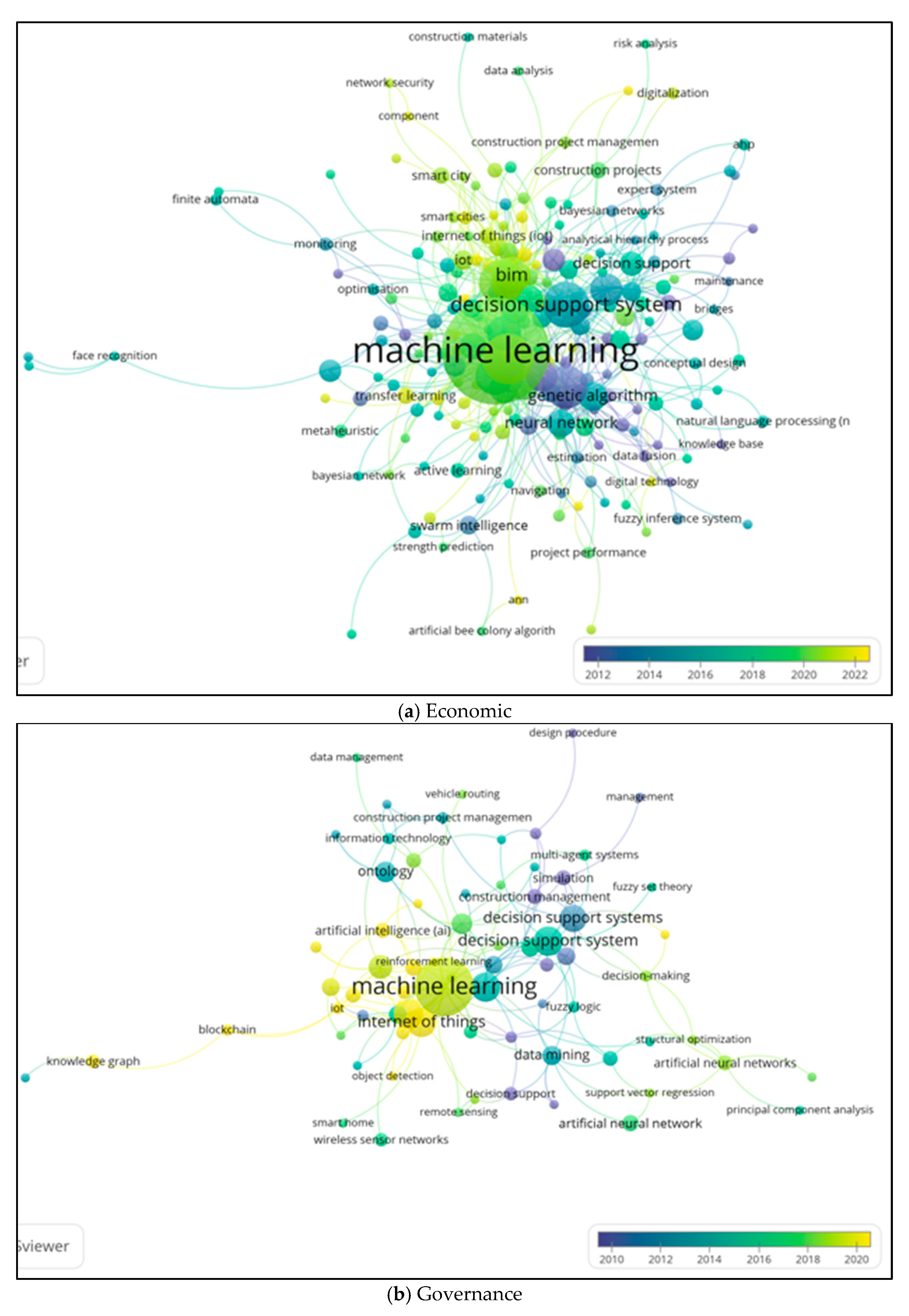





| Domain | Specifics |
|---|---|
| Data source | Scopus bibliographic repository |
| Covered period | From 1 January 2000 to 8 July 2023 |
| Number of publications | 3710 |
| Covered country contexts | 148 |
| Number of authors | 9567 |
| Number of universities | 1214 |
| Number of publishing sources | 937 |
| Number of papers in each sustainability pillar | Economic: 1973 (53.2%) Environmental: 430 (11.6%) Social: 462 (112.4%) Governance: 845 (22.8%) |
| Number of papers in each project stage | Design: 1161 (31.3%) Panning: 876 (23.6%) Construction: 1366 (36.8%) Operation and maintenance: 307 (8.3%) |
| Rank | Author | Affiliation | Country | Count | Share |
|---|---|---|---|---|---|
| 1 | Suangyu Wei | University of Nottingham | England | 10 | 2.23% |
| 2 | Yacine Rezqui | Cardiff University | England | 9 | 2.01% |
| 3 | Paige Wenbin Tien | University of Nottingham | England | 9 | 2.01% |
| 4 | Min-YuanCheng | National Taiwan University | China | 8 | 1.79% |
| 5 | Bruno Bouchard | University of Quebec | Canada | 7 | 1.56% |
| 6 | Calautit Kaiser | University of Nottingham | China | 7 | 1.56% |
| 7 | Albert Chan | Hong Kong Polytechnic University | China | 7 | 1.56% |
| 8 | Chimay Anumba, | University of Johannesburg | South Africa | 6 | 1.34% |
| 9 | Mehrdad Arashpour | Monash University | Australia | 6 | 1.34% |
| 10 | Abdenour Bououance | University du Quebec | Canada | 6 | 1.34% |
| Rank | University | Country | Count | Share |
|---|---|---|---|---|
| 1 | Hong Kong Polytechnic University | China | 43 | 0.96% |
| 2 | Politecnico di Milano | Italy | 30 | 0.67% |
| 3 | Nanyang Technological University | Singapore | 28 | 0.63% |
| 4 | Chinese Academy of Sciences | China | 28 | 0.63% |
| 5 | Tsinghua University | China | 27 | 0.60% |
| 6 | Carnegie Institute of technology | USA | 27 | 0.60% |
| 7 | Georgia Institute of Technology | USA | 26 | 0.58% |
| 8 | National Taiwan University | China | 25 | 0.56% |
| 9 | Politecnico di Torino | Italy | 24 | 0.54% |
| 10 | University of Florida | USA | 24 | 0.54% |
| Rank | Publishing Source | Subject Area | Type | Count | Citations | H-Index | Share |
|---|---|---|---|---|---|---|---|
| 1 | Advances in Intelligent systems and Computing | Computer Science and Engineering | Book Series | 161 | 525 | 58 | 3.59% |
| 2 | IEEE Access | Computer Science, Engineering, and Materials Science | Journal | 114 | 2237 | 204 | 2.54% |
| 3 | Automation in Construction | Engineering | Journal | 79 | 4197 | 157 | 1.76% |
| 4 | Energy and Building | Engineering | Journal | 67 | 3986 | 214 | 1.49% |
| 5 | Sensors | Computer Science and Engineering | Journal | 65 | 371 | 219 | 1.45% |
| 6 | Energies | Energy and Engineering | Journal | 58 | 791 | 132 | 1.29% |
| 7 | Building and Environment | Engineering, Environmental Science, and Social Science | Journal | 41 | 1589 | 189 | 0.92% |
| 8 | Journal of Building Engineering | Engineering | Journal | 33 | 765 | 129 | 0.74% |
| 9 | Journal of Construction Engineering and Management | Business, Management and Accounting and Engineering | Journal | 32 | 942 | 189 | 0.71% |
| 10 | Sustainable Cities and Society | Energy, Engineering, and Social Science | Journal | 27 | 1249 | 103 | 0.60% |
| Rank | Publication Title | Author | Research Focus | Year | Citation |
|---|---|---|---|---|---|
| 1 | Towards a semantic Construction Digital Twin: Directions for future research | Boje C.; Guerriero A.; Kubicki S.; Rezgui Y. | Big data, BIM, and construction safety. | 2020 | 359 |
| 2 | Roles of artificial intelligence in construction engineering and management: A critical review and future trends | Pan Y.; Zhang L. | Construction engineering and management. | 2019 | 269 |
| 3 | Automated progress monitoring using unordered daily construction photographs and IFC-based building information models | Golparvar-Fard M.; Peña-Mora F.; Savarese S. | 3D reconstruction, Automation, and Computer vision. | 2011 | 250 |
| 4 | A review of rotorcraft unmanned aerial vehicle (UAV) developments and applications in civil engineering | Liu P.; Chen A.Y.; Huang Y.N.; Han J.Y.; Lai J.S.; Kang S.C.; Wu T.H.; Wen M.C.; Tsai M.H. | Image processing and analysis and Unmanned aerial vehicle. | 2014 | 248 |
| 5 | An Internet of Things-enabled BIM platform for on-site assembly services in prefabricated construction | Li C.Z.; Xue F.; Li X.; Hong J.; Shen G.Q. | BIM, Decision-support system, Internet of Things, and Prefabricated construction. | 2018 | 235 |
| 6 | Artificial intelligence in the AEC industry: Scientometric analysis and visualization of research activities | Darko A.; Chan A.P.C.; Adabre M.A.; Edwards D.J.; Hosseini M.R.; Ameyaw E.E. | Automation, Digital transformation, Industry 4.0, and Machine intelligence. | 2020 | 214 |
| 7 | Application of machine learning to construction injury prediction | Tixier A.J.P.; Hallowell M.R.; Rajagopalan B.; Bowman D. | Construction safety, Machine learning, Predictive modeling, and Random Forest. | 2016 | 192 |
| 8 | Smartphone-based construction workers’ activity recognition and classification | Akhavian R.; Behzadan A.H. | Machine learning, Neural networks, and Smartphone sensors. | 2016 | 172 |
| 9 | Developing a Digital Twin at Building and City Levels: Case Study of West Cambridge Campus | Lu Q.; Parlikad A.K.; Woodall P.; Don Ranasinghe G.; Xie X.; Liang Z.; Konstantinou E.; Heaton J.; Schooling J. | Asset management, Digital twin (DT), and Operation and maintenance (O&M). | 2020 | 159 |
| 10 | Predicting concrete compressive strength using hybrid ensembling of surrogate machine-learning models | Asteris P.G.; Skentou A.D.; Bardhan A.; Samui P.; Pilakoutas K. | Hybrid modeling and Soft computing. | 2021 | 157 |
| Rank | University | Country | Count | Citations | Share |
|---|---|---|---|---|---|
| 1 | Carnegie Institute of technology | USA | 27 | 1282 | 0.60% |
| 2 | National Taiwan University | China | 25 | 1259 | 0.56% |
| 3 | Nanyang Technological University | Singapore | 28 | 1235 | 0.63% |
| 4 | Hong Kong Polytechnic University | China | 43 | 1135 | 0.96% |
| 5 | Georgia Institute of Technology | USA | 26 | 1031 | 0.58% |
| 6 | Tsinghua University | China | 27 | 673 | 0.60% |
| 7 | Chinese Academy of Sciences | China | 28 | 556 | 0.63% |
| 8 | University of Florida | USA | 24 | 318 | 0.54% |
| 9 | Politecnico di Milano | Italy | 30 | 242 | 0.67% |
| 10 | Politecnico di Torino | Italy | 24 | 194 | 0.54% |
| Rank | Country | Citation | Totally Strength | Year |
|---|---|---|---|---|
| 1 | USA | 17,143 | 343 | 2014 |
| 2 | England | 10,971 | 291 | 2016 |
| 3 | China | 9289 | 284 | 2019 |
| 4 | Italy | 4062 | 151 | 2011 |
| 5 | India | 3311 | 129 | 2022 |
| 6 | Australia | 3202 | 111 | 2019 |
| 7 | Germany | 2870 | 142 | 2018 |
| 8 | Taiwan | 2608 | 23 | 2017 |
| 9 | South Korea | 2604 | 65 | 2018 |
| 10 | Spain | 2590 | 130 | 2017 |
| Rank | Keyword | Occurrences | Total Strength | Year | Cluster |
|---|---|---|---|---|---|
| 1 | Machine Learning | 238 | 410 | 2019 | 5 |
| 2 | Deep Learning | 68 | 120 | 2021 | 4 |
| 3 | Neural Networks | 47 | 98 | 2017 | 5 |
| 4 | Big Data | 60 | 94 | 2019 | 3 |
| 5 | Internet of Things | 42 | 92 | 2020 | 2 |
| 6 | Decision-Support Systems | 72 | 89 | 2014 | 1 |
| 7 | Digital Twin | 26 | 72 | 2021 | 2 |
| 8 | Automation | 25 | 67 | 2015 | 4 |
| 9 | Computer Vision | 28 | 49 | 2017 | 5 |
| 10 | Fuzzy Logic | 30 | 49 | 2012 | 7 |
| Occurrence per Period | Ranks per Period | ||||||||
|---|---|---|---|---|---|---|---|---|---|
| Cluster | Keyword | 2000–2005 | 2006–2010 | 2011–2015 | 2016–2023 | 2000–2005 | 2006–2010 | 2011–2015 | 2016–2023 |
| 7 | Fuzzy Logic | 6 | 7 | 9 | - | 1 | 4 | 7 | - |
| 7 | Simulation | 6 | 9 | - | - | 2 | 3 | - | - |
| 5 | Neural Networks | 5 | 11 | 8 | - | 3 | 2 | 6 | - |
| 1 | Decision-Support Systems | 4 | 37 | 57 | 18 | 4 | 1 | 1 | 1 |
| 7 | Genetic Algorithms | 4 | 4 | 9 | - | 5 | 7 | 4 | - |
| 2 | Reinforced Learning | 2 | - | - | - | 7 | - | - | - |
| 6 | Image Processing | 2 | - | - | - | 8 | - | - | - |
| 3 | Building Information Systems | - | 3 | 10 | - | - | 10 | 3 | - |
| 3 | Data Mining | 2 | 7 | 4 | - | 9 | 5 | 5 | - |
| 1 | Automation | - | 3 | - | - | - | 8 | - | - |
| 5 | Machine Learning | 3 | 3 | 37 | 195 | 6 | 9 | 2 | 2 |
| 4 | Deep Learning | - | - | - | 66 | - | - | - | 3 |
| 3 | Big Data | - | - | 7 | 53 | - | - | 8 | 4 |
| 2 | Internet of Things | - | - | - | 40 | - | - | - | 5 |
| 1 | Robotics | 2 | 6 | 6 | 28 | 10 | 6 | 9 | 6 |
| 2 | Digital Twin | - | - | - | 26 | - | - | - | 7 |
| 6 | Computer vision | - | - | - | 23 | - | - | - | 8 |
| 5 | Support Vector Machine | - | - | - | 16 | - | - | - | 9 |
| 5 | Natural Language Processing | - | - | 4 | 14 | - | - | 10 | 10 |
| Research Clusters | Affiliation with Pillars of Sustainability and Construction Phases |
|---|---|
| Automation | Automation was the most predominant keyword cluster which leverages AI technologies to automate construction processes. It benefits all four phases of construction and aligns with the four pillars of sustainability. Automation involves the use of machinery, software, and other technologies to perform tasks that were traditionally manual, such as bricklaying, painting, and welding [34,48]. Drones are also utilized for site surveying, progress monitoring, and structural inspection [41]. Digital technologies like BIM automate tasks such as clash detection and cost estimating. Automation is a central focus in the construction industry, with AI technologies continually evolving around this cluster [34,48,49] |
| Digital Twin | The digital twin cluster is gaining significance in the construction industry, particularly in the economic and governance pillars and the planning and design phases. Digital twin involves creating virtual replicas of buildings or infrastructure systems using data from sensors and other sources. It enables simulation and testing of designs before construction, leading to cost reductions, improved performance, and increased efficiency [15]. Simulating and testing designs before construction is a key goal aligned with BIM. This model encompasses various dimensions of a construction project, allowing stakeholders to analyze aspects ranging from architectural design to structural integrity, systems integration, and operational efficiency [41]. AI enhances the capabilities of the digital twin by identifying patterns and anomalies and optimizing asset performance. However, the integration of digital twin technologies with other AI clusters remains relatively weak, indicating a need for further research in this area [2]. |
| Big Data | Big data plays a vital role in the social pillar and the construction phases, aiming to improve project outcomes. Construction professionals leverage the vast amount of data generated by projects to enhance safety on construction sites. Analyzing data on accidents and near-misses enables the identification of patterns and the development of strategies to reduce risks. For instance, training programs and safety protocols can be designed based on the most frequently occurring accidents [49]. |
| Information Systems | Information systems, frequently mentioned in the governance pillar and the planning, design, and operation and maintenance phases, involve AI-powered systems for efficient project management. These systems analyze data from multiple sources, including project schedules, personnel, equipment, and weather forecasts, to generate accurate schedules and optimize building design and performance [50]. The use of AI in information systems helps reduce energy consumption, improve building performance, and enhance occupant comfort [51]. |
| Simulation | Simulation, relevant to the governance and environmental pillars, as well as the planning, design, and operation and maintenance phases, plays a crucial role in optimizing project outcomes. Simulation techniques provide insights into the impact of different factors on project performance and identify potential issues before construction begins testing materials, layouts, and construction techniques, construction professionals can determine the most effective approach for a project [52]. Furthermore, simulation can predict the long-term performance of buildings and infrastructure systems, allowing for maintenance planning and asset replacement [15]. |
| Deep learning | Deep learning, a more recent research cluster, is mainly associated with the economic and social pillars and the construction phases. It has found application in quality control and defect detection, where AI models are trained to identify defects and anomalies in construction materials like concrete and steel [52]. Deep learning also improves resource management, reducing waste and improving efficiency on construction sites. Although the literature on deep learning in construction is relatively new, it has the potential to revolutionize the industry by enabling more accurate and cost-effective projects [41]. |
| Phases | Opportunities | Challenges |
|---|---|---|
| Planning | Optimized project schedule, accurate risk assessment and mitigation, selection of sustainable design alternatives, improved design making, enhanced project outcomes, identification and mitigation of risks, improved collaboration between stakeholders, resource optimization, efficient spatial planning, accurate feasibility by conducting simulations, assistance in ensuring compliance with regulatory requirements [41]. | Integration complexity, data integration and collaboration, data availability and quality, gaining acceptance from all project stakeholders, significant cost and required allocation of resources, expertise and skill requirements, data privacy and security, legal and ethical considerations, change management, uncertainty, and risk [53]. |
| Design | Parametric designs, design optimization and intelligent recommendations, cost, and time efficiency, facilitation of collaboration and data integration between stakeholders, design flaw identification, accurate simulation of design performance, and supporting the integration of sustainable practices and materials [32]. | System integration and data interoperability, industry standards and regulatory compliances, data quality and availability, user acceptance and adoption, and bias in design algorithms, may lead to a limited design diversity, overcoming technical limitations, data security and privacy, and continuous learning and adaption [45]. |
| Construction | Real-time monitoring, automation of repetitive tasks, improved safety by identifying potential hazards, advanced inspection and defect detection, resource allocation, enhanced productivity by streamlining workflows, improved collaboration and communication between stakeholders, quality control and assurance, remote construction management and cost control and budget management [29,33]. | Integration complexity with existing systems and workflows, interoperability with various equipment and data formats, communication between stakeholders, data accessibility and quality for up-to-date constriction data, change management to traditional construction practices, skill requirements and training, high initial investment and ongoing costs, limited industry adoption, system reliability and maintenance and legal and regulatory compliance [48,54]. |
| Operation and maintenance | Digital twins for real-time monitoring, predictive maintenance, operation and maintenance schedule generation, energy efficiency optimization, occupant comfort management, enhanced facility management, accurate lifecycle cost analysis, improved compliance and regulatory analytics, enhanced building performance evaluation, and streamlined documentation and reporting [2]. | Accurate capturing of data, data standardization and integration, privacy, and data governance, user-friendly and accessible to different stakeholders, skill requirements and training, seamless integration with current automated technologies, system reliability and maintenance, interdisciplinary collaboration, cost and resource allocation and change management [55]. |
| Pillars | Opportunities | Challenges |
|---|---|---|
| Economic | Cost savings through improved project efficiency and resource management, enhanced project profitability through optimized schedules, improved cost estimation accuracy, enhanced decision-making, and risk assessment, streamlined procurement processes and supply chain management, improved financial transparency and long-term cost benefits through adopting sustainable practices [30]. | Higher initial investment costs for implementing AI, balancing costs, and long-term economic benefits, ensuring accessibility between all stakeholders, addressing potential job displacement, overcoming resistance to change, ensuring data privacy and security, streamlined integration with existing technologies, limited availability of skilled AI professionals and ensuring compliance with legal and regulatory frameworks [56]. |
| Governance | Improvement transparency and accountability, enhanced decision-making and risk assessment, streamlined project approvals and regulatory compliance processes, efficient collation and communication between stakeholders, effective project governance and project monitoring, enhanced contract management and dispute resolution, and enhanced project oversight [57]. | Potential biases in the algorithms, compliance with data privacy and regulations, overcoming resistance to change, ensuring transparency and accountability, and ensuring compatibility with existing governance frameworks [58]. |
| Social | Enhance worker safety through risk assessment and monitoring, improve labor conditions and welfare through optimizing resource allocation, enhanced worker productivity, and enhanced stakeholder involvement in projects [59]. | Job displacement and workforce transition, ensuring equal access to AI technologies, overcoming resistance to change, ensuring stakeholder engagement, data privacy and protection, balancing automation, and human interaction, addressing potential social disruptions, and ensuring social acceptance [60]. |
| Environmental | Reduce carbon footprint and emissions through AI-optimized construction processes, efficient use of resources and materials, enhanced resource management and waste reduction, enhanced energy efficiency and sustainable building designs through simulation and optimization, improved air and water quality through pollution monitoring and control systems, AI-informed environmental impact assessment and sustainable land use planning g, reduce environmental risk through AI risk assessment and mitigation strategies and promote adaptive and resilience infrastructure designs [32]. | Ensuring accurate and reliable data for monitoring and assessment, overcoming technological limitations and construction for environmental solutions, Incorporate complex and dynamic environmental factors into AI models and simulations, balancing the trade-offs between environmental considerations and other project objectives, ensuring compliance with environmental regulations, addressing conflicts between economic consideration and environmental objective, integrating AI technologies with existing environmental management systems and ensuring long-term sustainable and maintenance of environmental solutions [16]. |
Disclaimer/Publisher’s Note: The statements, opinions and data contained in all publications are solely those of the individual author(s) and contributor(s) and not of MDPI and/or the editor(s). MDPI and/or the editor(s) disclaim responsibility for any injury to people or property resulting from any ideas, methods, instructions or products referred to in the content. |
© 2023 by the authors. Licensee MDPI, Basel, Switzerland. This article is an open access article distributed under the terms and conditions of the Creative Commons Attribution (CC BY) license (https://creativecommons.org/licenses/by/4.0/).
Share and Cite
Regona, M.; Yigitcanlar, T.; Hon, C.K.H.; Teo, M. Mapping Two Decades of AI in Construction Research: A Scientometric Analysis from the Sustainability and Construction Phases Lenses. Buildings 2023, 13, 2346. https://doi.org/10.3390/buildings13092346
Regona M, Yigitcanlar T, Hon CKH, Teo M. Mapping Two Decades of AI in Construction Research: A Scientometric Analysis from the Sustainability and Construction Phases Lenses. Buildings. 2023; 13(9):2346. https://doi.org/10.3390/buildings13092346
Chicago/Turabian StyleRegona, Massimo, Tan Yigitcanlar, Carol K. H. Hon, and Melissa Teo. 2023. "Mapping Two Decades of AI in Construction Research: A Scientometric Analysis from the Sustainability and Construction Phases Lenses" Buildings 13, no. 9: 2346. https://doi.org/10.3390/buildings13092346
APA StyleRegona, M., Yigitcanlar, T., Hon, C. K. H., & Teo, M. (2023). Mapping Two Decades of AI in Construction Research: A Scientometric Analysis from the Sustainability and Construction Phases Lenses. Buildings, 13(9), 2346. https://doi.org/10.3390/buildings13092346









